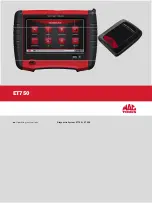
PAGE 8
T E C A L 4 2 5 H O P E R A T O R ’ S M A N U A L
INTRODUCTION
Before using the Tecal Calibrator, make sure you have read this
manual carefully. If you have any queries, contact your supplier.
The Tecal Calibrator is designed to provide safe and convenient calibration of
a wide range of thermal sensors. It features fast heat up times, with
accuracy and repeatability.
The Tecal Calibrator can calibrate temperature probes without the need to
return them to a specialist laboratory. To ensure accuracy the unit must be
operated in an environment with a stable ambient temperature.
The thermal sensors are placed in a well in the temperature controlled block.
A number of inserts is available with different dimension wells to match
standard probe sizes: these are detailed towards the back of this manual.
The unit is supplied with an internal battery for holding program information in
memory. Under normal operation of use, with the unit being switch on for a
minimum of 5 hours a month, the battery should never go flat as it is trickle
charged from the internal electronics.
If the unit is not used for a long period, over six months, we advise that the
unit is connected to the mains electrical supply and switched on for a
minimum of 5 hours before use.
Applications
The calibrator has three main applications:
Maintaining a set temperature
The required temperature is set on the calibrator and the operation of the
probe is checked.
A NAMAS certificate can be provided, contact your dealer for details.
Temperature cycling
You can connect a PC to the Tecal unit using Techne's Data Logging
software, CALSOFT, to gather data. You may also print out profiles using
the printer connected to the PC. Programs can be created and run directly
on the calibrator.
A sequence of temperatures (each with a heat up/cool down rate and a hold
time) may be stored as a program and recalled from memory. A program
consists of:
•
a series of specified temperatures
•
the times for which samples are to be maintained at each specified
temperature (hold times)
•
the desired heating or cooling rates in between each specified
temperature (ramp rates), and
•
the number of times that a sequence is repeated.











































